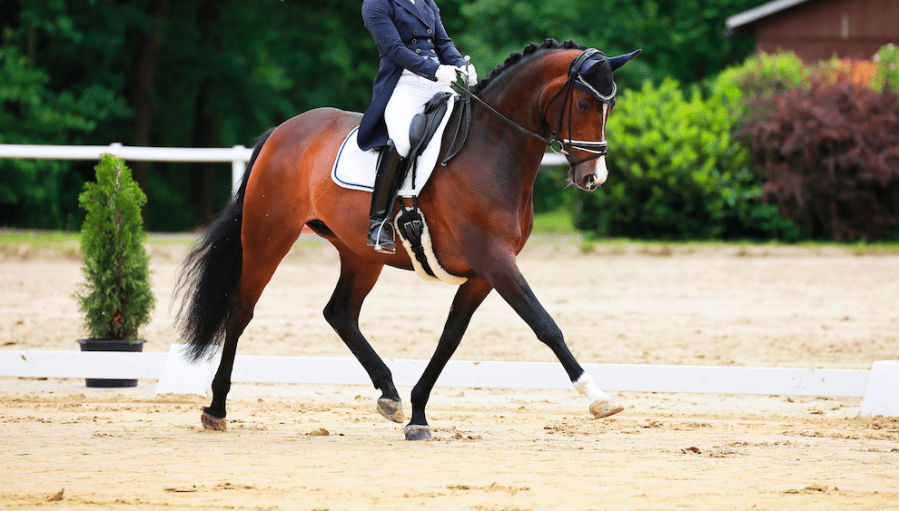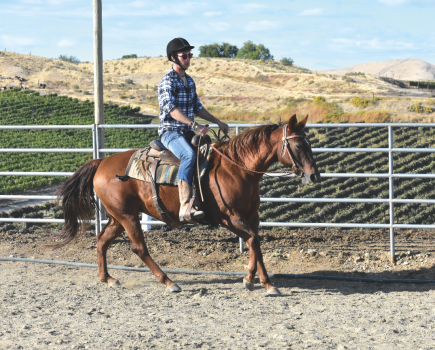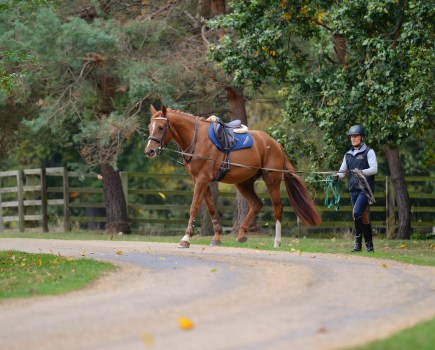It’s a question every competitive rider asks themselves at some stage: how can I improve my dressage score? If you’re stuck in the 50 or 60% bracket and wonder what the difference is to crack 60 or 70%, you’re not alone. It’s frustrating to hit a plateau with your dressage marks — we’ve all been there.
Dressage training is more of a marathon than a sprint, and improvement doesn’t happen overnight. But we have good news: it may be that you’re throwing away precious marks without realising it. All it takes is a little extra thought and preparation to put you on track for a great test.
How can I improve my dressage score?
We asked dressage judges exactly where marks are typically lost and what they want to see in order to award nines and 10s rather than fives and sixes. These are the key areas they highlighted:
- Accuracy of movements and transitions
- Knowing the test well
- Ensuring halts are square
- Being able to ride in a straight line (not just in a circle)
- Having impulsion
- Not dwelling on mistakes/movements that could have been better
- Riding into corners — don’t cut them!
- Understanding the directives
- Riding well between the movements — not just the movements themselves
- Making sure you have energy in the pace and not speed
- Don’t fiddle with the horse’s head
- Think ahead and prepare for a movement
- Establish a correct outline — behind the vertical is a common sight and this is incorrect
- Read your test sheet and learn from it for next time.
Read on to learn what these mean and find out what the judges want to see…
Be accurate
First and foremost, you need to be accurate. There is a reason this is at the top of this list because it really is important. So important, in fact, that being precise can put you at the top of the scoreboard in dressage.
“If your 20m circles look more like two corners and a straight line, you really are damaging your score. Same with crooked centre lines,” laments List One judge Paul Hayler, who was appointed as training director for British Dressage (BD) in 2014.
“Judges expect every shape and movement to be ridden correctly and precisely, in the exact place specified on the test sheet.”
So if the test requires you to walk at A, that means walk at A. If it states canter at C, you must canter at C — not a few steps before or after. Sounds simple, yes? Yet this is where marks are commonly lost.
“It’s all about accuracy,” agrees international dressage rider Kate Cowell. “You will be rewarded with good marks just by being accurate and correct, for example ensuring that your transitions are exactly on the markers and that you are straight and make the correct size shapes.
“Clarity of transitions is also a good way to gain extra marks.”
Accuracy is learned at home
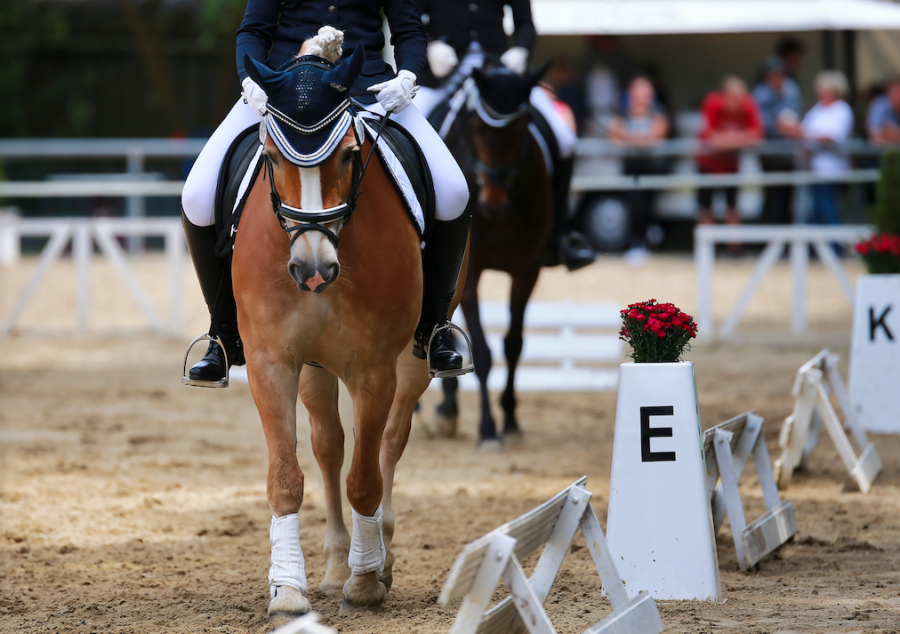
Being accurate can mean the difference between winning and losing
To be accurate in a test you need to be accurate when you’re training too. Whether it’s letters or a cone or a different coloured fence post, pick a spot to ride a movement at and do it.
“A gripe of mine is carelessness,” says BD List 6 judge and classical trainer Claire Lilley. “Accuracy is important in a horse’s training, and if you don’t ride each movement accurately at home then your horse isn’t going to develop the correct degree of suppleness and flexibility.
“A tatty test is due to rider error and often it’s down to little mistakes that could be corrected with good training – leaving the rider in the placings as opposed to way down the leaderboard.
Know the test well
“So many riders rely on callers these days, but it’s really important to know your test inside out,” says dressage coach Kirsty Mepham, who partnered Dikkiloo at the Sydney 2000 Olympics as a member of Team GB.
“One of the most common issues I see is the caller announcing the next movement just as the rider is getting to the marker, which is too late to make a good attempt at it, resulting in mistakes and low marks.”
Windy weather making it impossible to hear them, someone else calling in the next arena and confusing you, your caller being ill on the day — these are other reasons to learn the test.
“Having a caller as a backup in case of a mind blank is OK, but know the test too,” advises Kirsty. “You can’t have a caller at regionals or championships, so it’s worth finding a way to memorise your tests early on.”
Halts must be square
The halt is always the last movement in every dressage test — and some tests require you to do one immediately after entering at A and during the test too.
“I see many riders throwing away easy marks because the halt is not square,” explains Kirsty.
“I expect to see both pairs of hooves, front and back, aligned. Riders need to be pickier and train the halt at home to prevent them losing marks on an easily trainable movement.”
Practice straight lines
It’s harder to ride in a straight line than you might think. Especially if you mostly train in circles at home and you’re used to working alongside a fence.
“I see a lack of straightness in many of the movements, with canter and transitions being particularly troublesome, especially on the long side,” confirms Kirsty.
“The biggest issue is the horse’s quarters swinging in. Training at home is key to correcting this.”
Top tips
- Practise shoulder-in when you’re schooling as this corrects quarters in at all paces.
- Ride off the outside track regularly so that your horse doesn’t rely on the fence to keep them straight.
- Don’t just ride circles when training, ride squares and lots of straight lines too.
- “Ride with your hands slightly wider and held further forward. This stops you from over-correcting, especially on straight lines.”
Transitions must be sharp
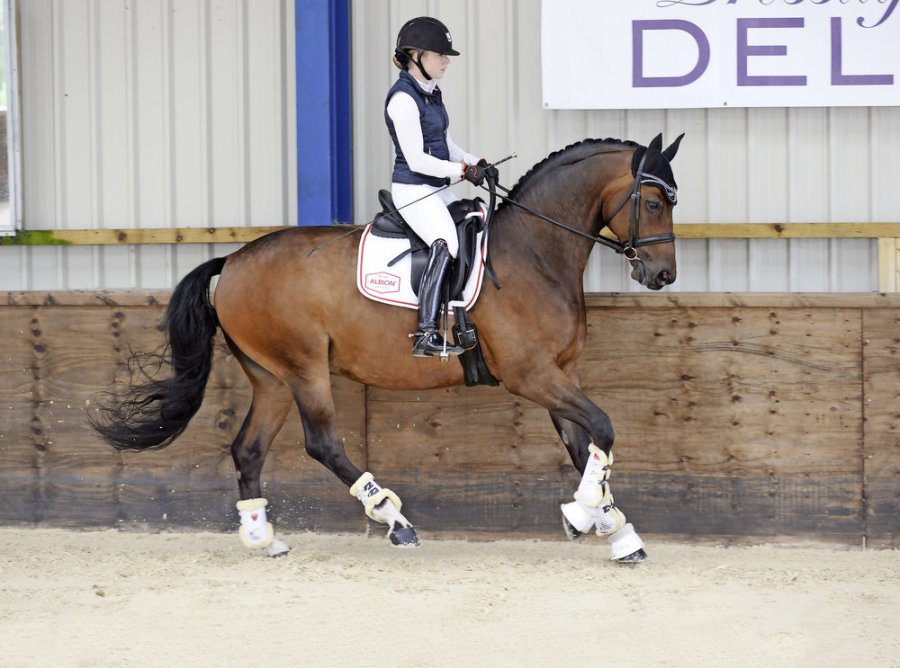
Every transition needs to be sharp and accurate
Transitions between paces (ie walk to trot) and within the paces (ie medium walk to free walk) are an important part of every dressage test. The judge is looking for clear execution.
“I see riders panic about transitions, especially when riding trot-walk-trot and trot-canter-trot,” says Kirsty.
“I’m looking for a clear transition with three to four strides between each pace, but often they are rushed, as if the rider is desperate to get the movement over with.
“They will ride only one stride before transitioning again and it’s an easy way to lose marks. I’d rather see too many strides than not enough. Free walk to medium walk and back also causes issues.”
Top tips
- Transitions are easier to nail when your horse is straight, so work on this, not just the transitions.
- Preparation is key. Sit straight and use your bodyweight, not the reins, to ride a downwards transition and keep your leg on. Think ‘going forwards’ to walk, rather than ‘coming back’ to walk.
- For transitions within the pace, count the rhythm as you ride it. It shouldn’t change.
You need impulsion
“Lack of impulsion is an issue across all dressage levels and particularly when collected movements are required,” says Paul Hayler.
“Collection is controlled power, not slowing down. Without power, the movement, swing and suppleness is lost.
“As your horse becomes more experienced and starts to go up the levels, we look to see more engagement and impulsion with your horse staying off their forehand.”
Issues with loss of impulsion is often seen when riding in and out of transitions, with fluency into the next movement subsequently disrupted.
Top tip
- A simple but effective way to increase impulsion is to ride a 20m circle in trot and gradually reduce its size. Keep the energy in the pace the same and don’t let the horse slow down. As the circle gets smaller, they will lift their shoulders and engage the hindlegs in response.
Focus on the next movement
Each movement in a dressage test is judged individually. It is important to know where each one starts and finishes so that you ride accurately in order to get the best results.
“The issue I see here is when things go wrong,” explains Paul. “Rather than quickly regrouping after a wobble and riding for the next movement, the rider allows the problem to continue, so points are lost on two or three movements rather than just the one where the mistake occurred.”
Don’t panic if you know a movement hasn’t gone well. Focus on what’s coming next rather than what’s just happened.
Use the corners
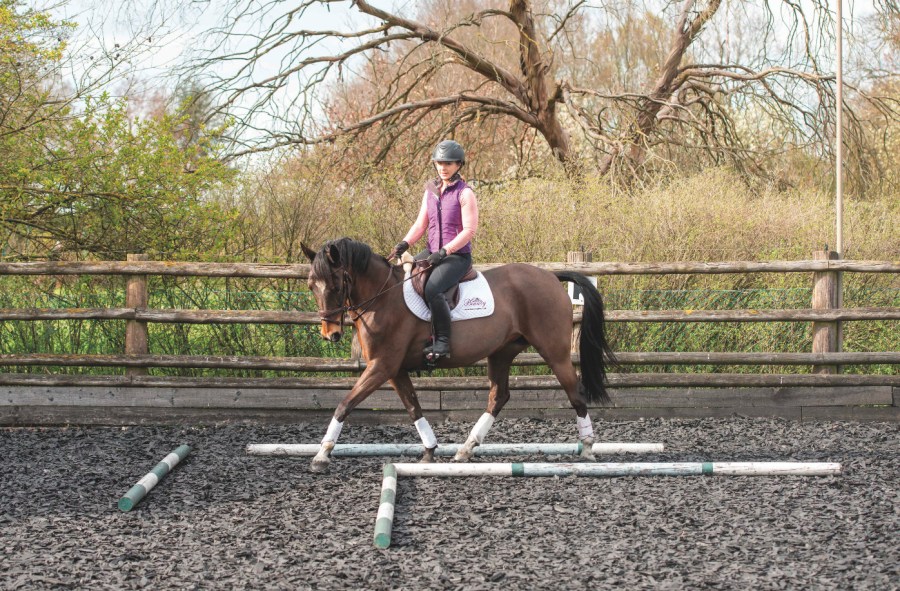
Practice riding good corners at home
Cutting corners is easy to do and a big no-no.
“Riders forget that corners are a continuation of the test, and the judge will be looking for them be ridden correctly,” advises Paul.
“You need balance and control with no cutting them short. If you ride corners like this, then the rest of the test is likely to be good, too. If not, then you run the risk of ruining the next movement.”
When ridden correctly, corners give you time before you have to do the next movement.
“Competitors often don’t ride their corners correctly or deep enough,” agrees BD List 3A judge John Lassetter.
“You should always ride deep into the corner, maintaining your horse’s rhythm and balance. This way it gives you more time to prepare for the next movement, whatever that is.
“I perpetually see riders doing a half circle between H and M, instead of riding a correct corner. They then don’t have time to set the horse up correctly and so maybe overshoot the centre line or make another mistake.”
Top tip
- Place a safe object like a cone in the corner of your arena with enough space for your horse to pass between it and the fence. Start with plenty of space at first and gradually move the cone in. This is a good way to practice riding into a corner.
Understand the marks and directives
Know which movements attract double marks in your test and train these to perfection. The free walk on a loose rein, for example, is usually worth double marks (20) and so is an important movement to be able to ride well. This starts with understanding what a good free walk is and how to ask for it.
The directives are at the bottom of the test sheet. Study these too, as it gives you information about what you need to do to impress the judge.
Show your horse off
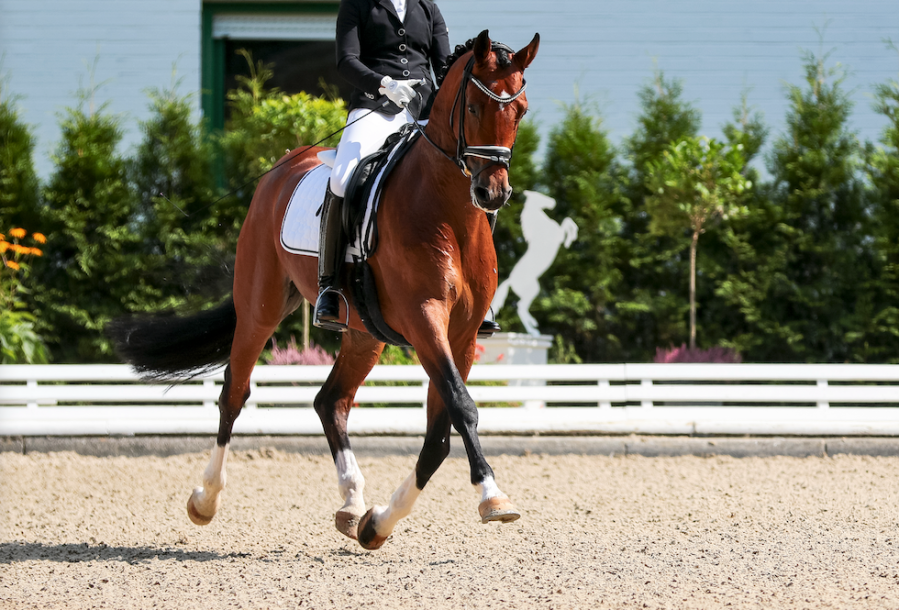
At every level, it’s the rider’s job to show the horse off
If your horse has three good paces, show them off by giving them enough energy and freedom to move forward. Don’t restrict forwardness with your hands.
Remember as well that the judge knows nothing about your horse and they will mark what they see. So, if your warm up hasn’t gone well or you arrived late or you haven’t been able to ride your horse a few days before test day, forget about it. Ride into that arena, sit tall and proud, and ride your horse to the best of your ability.
Make every step count
Remember to ride the bits between the movements in a dressage test. The judge’s eyes will be on you all the time and nothing should be left to chance for the higher marks. Finish the test with a smile and a positive salute, no matter how it went.
“Whenever I’m judging I want to see riders riding between the movements, as well as riding the actual movements. Above all, they need to understand each movement in a test and ride each as correctly as possible, with suppleness and flexibility,” says Claire Lilley.
Think about your position
Keep your head up, shoulders back, heels and sit centrally in the saddle. Don’t allow nerves or the pressure force you to lean forward or look down. You’re not allowed to use your voice either, which includes clicking, and you’ll be penalised if you do. So stay quiet!
“Poor rider position is another of my gripes when I’m judging,” says John Lassetter. “So often you see riders who look as though they’re on a motorbike rather than a horse – leaning in around the corners in a wall-of-death style.
“Riders should always aim to keep their upper body level with the shoulders and hips of their horse, so that he or she can stay in an upright mode.”
Look ahead
Show the judges that you mean business by looking up and in the direction of where you’re going. This will help you communicate with your horse where you want to go too. Remember, body language is important and rider weight aids are very useful.
Hone your horse’s paces
Collective marks are awarded for your horse’s paces.
“A horse’s paces can also be developed with time and work. Consistently working through the scales of training (rhythm, suppleness, contact, impulsion, straightness and collection) is a systematic and attainable way of developing your horse’s expression correctly,” says Kate Cowell.
“You can also develop the ease of movements and confidence in the work. The aim of dressage is to make it look happy and easy.”
Fitness counts
“It’s also important to remember that a fit and muscled horse will product a better test,” adds Kate.
“Consider your horse’s feed and management and talk to your trainer to develop tailor-made exercises specific to your horse and repeat them regularly. Keep developing the finesse of your aids.”
Don’t confuse energy with speed
Sonia Berry, a BD List 6 judge who has ridden at Grand Prix level, would like to see competitors take their feet off the accelerator during a test.
“My pet hate is riders going too fast, thinking that speed equates to energy,” she says. “They’re told their horse should come through from behind but mistake this for speed and start rushing everywhere at 90 miles an hour.”
A horse who is rushing will lose balance, fall onto the forehand and be trickier to ride. Make sure you’re asking energy, not speed.
Leave the horse’s head alone
“Another bugbear is riders fiddling with the bit,” continues Sonia. “I hate to see lots of movement through the hands.”
Avoid fiddling with the reins, as this is likely to lead to an unsettled horse with an inconsistent contact. You will lose a lot of marks for this.
Think ahead
“Certain dressage tests often throw up a mistake that’s repeated or poorly ridden time and time again,” states BD judge Elizabeth Roberts.
“One of the things I always look out for is how riders prepare for transitions or turns.
“At the lower levels, it’s common to see a surprised expression on a horse’s face when the rider suddenly either makes a sharp turn or a ‘trot now/canter now’ aid, rather than the ‘prepare, give an indication to the horse that something might be happening’ (half-halt) and then the aid.
“Sometimes you see a horse looking rather shocked as he or she is surprised into the transition.”
Prepare, prepare, prepare!
“My pet hate is those riders who throw marks away through lack of preparation,” says Alison Woulds, a BD List 5 judge who has ridden at Grand Prix level. “A common example is when they’re asked to ride down the centre line, but they don’t actually go on the centre line, instead they overshoot it. Or they attempt to ride a 15- or 20-metre circle and it isn’t accurate.
“If you’ve got 25 competitors in a class, you’ll always see the odd one or two who haven’t prepared well enough.
“I feel like shouting at them: ‘You could have won if you’d only trained harder and spent more time preparing for this test!’”
Establish a correct outline
“The most common problem I see when I’m judging is people riding their horses over-bent,” says Claire Lilley.
“They’re obviously confused about what’s right and what’s wrong with regards to their horse’s outline, and I regularly see horses with their chin on their chest, but their back end trailing behind.
“I think a large number of riders aren’t being taught the correct way to ride into a contact.
“Above all, riders need to think of their horse as a whole and learn how to hold a contact,” continues Claire. “Of course, anyone can have a momentary slip where their horse loses the contact, but your aim should be to have your horse on the bit, while holding an even contact.
“If I see someone riding their horse over-bent, I will say something. If they’re riding a couple of horses in the same competition and don’t take heed of my comments, then I’ll start getting tough on their marks. I’ve been known to get out of the judge’s car and go up to a rider to make my point.”
Don’t rush immobility
Some dressage tests require immobility. This is a brief pause, where your horse stands still, but it’s longer than many riders think and easily rushed.
“If you’re asked to halt for four seconds at C, make sure you count steadily to four. One Mississippi… two Mississippi…,” advises Alex Gingell, Level 1 FEI judge and List 3a BD judge.
“Don’t rush to get to four, which is easy to do if you’re nervous. Practice counting to four with a stopwatch at home, so that you get a feel for how long four seconds actually is. You might be surprised!”
Read your test sheet
However good or bad your test is, use it as a benchmark for improvement. Always collect your score sheet at the end of the day and take note of the comments. Think of it as constructive feedback for you to take away and work on.
Over time, you’ll be able to look back at your horse’s dressage sheets and see how they’ve improved in certain areas.

